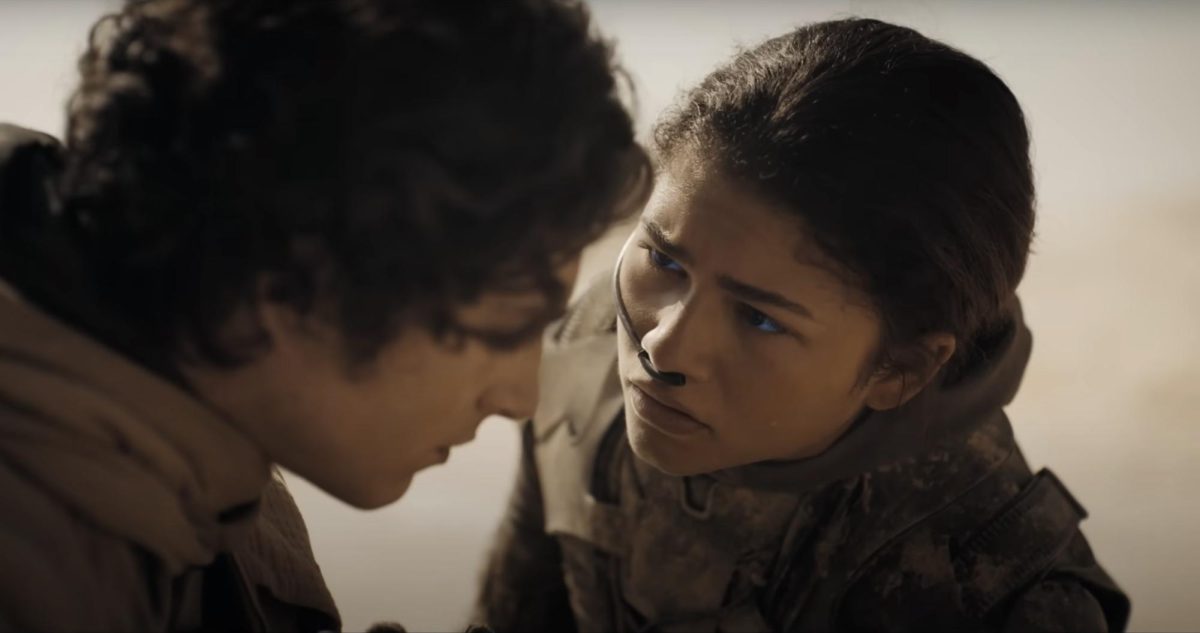There has been especially large vocabulary used to describe Denis Villeneuve’s second installment in the “Dune” trilogy — epic, massive, saga and space opera, to name a few. This language may seem dramatic until you experience “Dune: Part Two.” Gigantic in every sense, this film exemplifies the grandeur of Frank Herbet’s classic novels. “Dune: Part Two” is bigger, bolder and better than its predecessor — and possibly every sci-fi film that has come before.
“Dune: Part Two” is the second movie in a three-part saga adapting Frank Herbert’s “Dune” series. While it’s nearly impossible to summarize in concise terms, the film follows Paul Atreides, played by Timothée Chalamet, as he fights the Harkonnen House, led by Vladimir and Feyd-Rautha Harkonnen, played by Stellan Skarsgård and Austin Butler, respectively. Fighting alongside Paul are the Fremen, the inhabitants of the desolate desert that covers most of the planet Arrakis. As they prepare for war against the House Harkonnen, Paul falls for a Fremen woman named Chani, played by Zendaya, forcing him to reckon with his status as a lover, fighter and messiah.
The cast is about as star-studded as they come. Along with the previously mentioned actors, Florence Pugh, Rebecca Ferguson, Josh Brolin, Dave Bautista, Javier Bardem and Christopher Walken fill out the rest of the cast. While some critics have complained that the film feels like watching the red carpet at the MET Gala and that some unknowns should have been cast, the film doesn’t limit itself to the science fiction genre, so well-established and talented actors were necessary to balance the complex nature of the script.
Denis Villeneuve, with his co-writer Jon Spaihts, came to address the “‘Dune’ was boring” allegations, and they surely delivered. The first film was catered towards the patient, but its follow-up packs the action from the first minute. Expanding on the world established in the first one, the film sets political intrigue and conspicuous religious commentary within a grand space empire setting. Thanks in part to its nearly three-hour run time, the film thoroughly explores each facet of the film.
“Dune” is often labeled as an allegory for oil production in the Middle East, and while the first film shied away from this, the second embraced it. However, Villeneuve still stopped short of fully adopting this by failing to hire actors from the Middle East and North Africa. Most of the religious aspects of the film are ripped straight from Islam, but the film acts as a commentary of religious fundamentalism as a whole. With stakes so high, it’s easy to create a war film where characters are defined by the side of the fight they are on, but each character is fleshed out. Paul and Chani’s relationship feels incredibly intimate — even if their development involves riding a giant desert snake. Paul’s foil, Feyd-Rautha, is utterly deranged, yet oozes charisma, a testament to both the writing and Austin Butler’s acting ability when he drops that Elvis accent.
The script is something to marvel at, and will inevitably bring in awards. However, the craftsmanship is undeniably the best part of the film. The wording here is intentionally vague, as everything — from the cinematography to the sound design — is masterful. Starting with what you can see, Arrakis is visually enchanting. Greig Fraser’s cinematography is generational. The sweeping shots of the largely desolate Arrakis still feel alive, with the shimmering spice that covers the land. The way the camera plays with light and shadow creates a mesmerizing visual tapestry, enhancing the film’s atmosphere. Giedi Prime, the planet from which the Harkonnens hail, is black and white, reflecting the sinister nature of its inhabitants. Every scene on the planet is crisp and otherworldly. Accomplishing sandworm riding that doesn’t scream “CGI” at the audience is incredibly difficult, so the special effects are another high point. The fight scenes are also magnificent.
Moving on to what you can hear, Hans Zimmer brings his unparalleled talent to the score. Sci-fi scores can often blend together and sound the same, but everything about the music in “Dune: Part Two” is distinct. The sound design may be one of the most underrated portions of the technical aspects. Being able to efficiently switch between loud battle scenes to intimate moments between characters is something that many science fiction films are unable to do, but this film proves that it can be done, and done well.
This film was under immense pressure. The sophomore slump is usually attributed to music, but film is no exception. Science fiction trilogies are especially victim to this. With the exception of “The Dark Knight” and “The Empire Strikes Back,” sequels are often low points. The “Star Wars” comparisons came as soon as Villeneuve started this project, which is understandable as “Star Wars” was inspired by the novel “Dune” in the first place.
“Dune: Part Two” takes what “Empire Strikes Back” got right — expanding on the world and narrative, along with narrowing in on our hero — and perfects it by adding a deeper level of social commentary the original “Star Wars” trilogy lacked. I walked out of this film with my jaw on the floor. This is the generation-defining science fiction film that we deserve.


